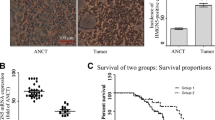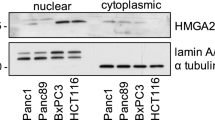Abstract
High mobility group A1 (HMGA1), as a major member of HMGA family, plays an important part in promotion of cell proliferation and motility, induction of epithelial-mesenchymal transition, and maintenance of stemness, but little is known about the pathological role of HMGA1 in breast cancer patients. The aim of this study was to identify the pathological roles of HMGA1 in breast cancer. In our results, we found that mRNA and protein expression levels of HMGA1 were markedly higher in breast cancer tissues than in normal breast tissues. Using immunohistochemistry, high levels of HMGA1 protein were positively correlated with the status of histological grade (I–II vs. III–IV; P = 0.023), clinical stage (I–II vs. III–IV; P = 0.008), tumor size (T1–T2 vs. T3–T4; P = 0.015), lymph node metastasis (N0–N1 vs. N2–N3; P = 0.002), distant metastasis (M0 vs. M1; P < 0.001), and triple-negative breast cancer (No vs. Yes; P = 0.014) of breast cancer patients. Patients with higher HMGA1 expression had a significantly shorter overall survival time than did patients with low HMGA1 expression. Multivariate analysis indicated that the level of HMGA1 expression was an independent prognostic indicator (P < 0.001) for the survival of patients with breast cancer. In conclusion, HMGA1 plays an important role on breast cancer aggressiveness and prognosis and may act as a promising target for prognostic prediction.



Similar content being viewed by others
References
Siegel R, Ma J, Zou Z, Jemal A (2014) Cancer statistics, 2014. CA Cancer J Clin 64(1):9–29. doi:10.3322/caac.21208
Hortobagyi GN, de la Garza Salazar J, Pritchard K, Amadori D, Haidinger R, Hudis CA, Khaled H, Liu MC, Martin M, Namer M, O’Shaughnessy JA, Shen ZZ, Albain KS (2005) The global breast cancer burden: variations in epidemiology and survival. Clin Breast Cancer 6(5):391–401
Cowin P, Rowlands TM, Hatsell SJ (2005) Cadherins and castenins in breast cancer. Curr Opin Cell Biol 17(5):499–508. doi:10.1016/j.ceb.2005.08.014
Shah SN, Resar LM (2012) High mobility group A1 and cancer: potential biomarker and therapeutic target. Histol Histopathol 27(5):567–579
Cleynen I, Van de Ven WJ (2008) The HMGA proteins: a myriad of functions (Review). Int J Oncol 32(2):289–305
Pogna EA, Clayton AL, Mahadevan LC (2010) Signalling to chromatin through post-translational modifications of HMGN. Biochim Biophys Acta 1799(1–2):93–100. doi:10.1016/j.bbagrm.2009.11.018
Tamimi Y, van der Poel HG, Denyn MM, Umbas R, Karthaus HF, Debruyne FM, Schalken JA (1993) Increased expression of high mobility group protein I(Y) in high grade prostatic cancer determined by in situ hybridization. Cancer Res 53(22):5512–5516
Tamimi Y, van der Poel HG, Karthaus HF, Debruyne FM, Schalken JA (1996) A retrospective study of high mobility group protein I(Y) as progression marker for prostate cancer determined by in situ hybridization. Br J Cancer 74(4):573–578
Fedele M, Bandiera A, Chiappetta G, Battista S, Viglietto G, Manfioletti G, Casamassimi A, Santoro M, Giancotti V, Fusco A (1996) Human colorectal carcinomas express high levels of high mobility group HMGI(Y) proteins. Cancer Res 56(8):1896–1901
Chiappetta G, Botti G, Monaco M, Pasquinelli R, Pentimalli F, Di Bonito M, D’Aiuto G, Fedele M, Iuliano R, Palmieri EA, Pierantoni GM, Giancotti V, Fusco A (2004) HMGA1 protein overexpression in human breast carcinomas: correlation with ErbB2 expression. Clin Cancer Res 10(22):7637–7644. doi:10.1158/1078-0432.ccr-04-0291
Abe N, Watanabe T, Masaki T, Mori T, Sugiyama M, Uchimura H, Fujioka Y, Chiappetta G, Fusco A, Atomi Y (2000) Pancreatic duct cell carcinomas express high levels of high mobility group I(Y) proteins. Cancer Res 60(12):3117–3122
Masciullo V, Baldassarre G, Pentimalli F, Berlingieri MT, Boccia A, Chiappetta G, Palazzo J, Manfioletti G, Giancotti V, Viglietto G, Scambia G, Fusco A (2003) HMGA1 protein over-expression is a frequent feature of epithelial ovarian carcinomas. Carcinogenesis 24(7):1191–1198. doi:10.1093/carcin/bgg075
Liu WM, Guerra-Vladusic FK, Kurakata S, Lupu R, Kohwi-Shigematsu T (1999) HMG-I(Y) recognizes base-unpairing regions of matrix attachment sequences and its increased expression is directly linked to metastatic breast cancer phenotype. Cancer Res 59(22):5695–5703
Pegoraro S, Ros G, Piazza S, Sommaggio R, Ciani Y, Rosato A, Sgarra R, Del Sal G, Manfioletti G (2013) HMGA1 promotes metastatic processes in basal-like breast cancer regulating EMT and stemness. Oncotarget 4(8):1293–1308
Shah SN, Cope L, Poh W, Belton A, Roy S, Talbot CC Jr, Sukumar S, Huso DL, Resar LM (2013) HMGA1: a master regulator of tumor progression in triple-negative breast cancer cells. PLoS One 8(5):e63419. doi:10.1371/journal.pone.0063419
Sarhadi VK, Wikman H, Salmenkivi K, Kuosma E, Sioris T, Salo J, Karjalainen A, Knuutila S, Anttila S (2006) Increased expression of high mobility group A proteins in lung cancer. J Pathol 209(2):206–212. doi:10.1002/path.1960
Takahashi Y, Sawada G, Sato T, Kurashige J, Mima K, Matsumura T, Uchi R, Ueo H, Ishibashi M, Takano Y, Akiyoshi S, Eguchi H, Sudo T, Sugimachi K, Tanaka J, Kudo SE, Doki Y, Mori M, Mimori K (2013) Microarray analysis reveals that high mobility group A1 is involved in colorectal cancer metastasis. Oncol Rep 30(3):1488–1496. doi:10.3892/or.2013.2602
Chang ZG, Yang LY, Wang W, Peng JX, Huang GW, Tao YM, Ding X (2005) Determination of high mobility group A1 (HMGA1) expression in hepatocellular carcinoma: a potential prognostic marker. Dig Dis Sci 50(10):1764–1770. doi:10.1007/s10620-005-2934-9
van der Zee JA, ten Hagen TL, Hop WC, van Dekken H, Dicheva BM, Seynhaeve AL, Koning GA, Eggermont AM, van Eijck CH (2010) Differential expression and prognostic value of HMGA1 in pancreatic head and periampullary cancer. Eur J Cancer 46(18):3393–3399. doi:10.1016/j.ejca.2010.07.024
Hristov AC, Cope L, Di Cello F, Reyes MD, Singh M, Hillion JA, Belton A, Joseph B, Schuldenfrei A, Iacobuzio-Donahue CA, Maitra A, Resar LM (2010) HMGA1 correlates with advanced tumor grade and decreased survival in pancreatic ductal adenocarcinoma. Mod Pathol 23(1):98–104. doi:10.1038/modpathol.2009.139
Liau SS, Whang E (2009) High mobility group A: a novel biomarker and therapeutic target in pancreatic adenocarcinoma. Surgeon 7(5):297–306
Qu Y, Wang Y, Ma J, Zhang Y, Meng N, Li H, Wang Y, Wei W (2013) Overexpression of high mobility group A1 protein in human uveal melanomas: implication for prognosis. PLoS One 8(7):e68724. doi:10.1371/journal.pone.0068724
Liu Z, Li X, He X, Jiang Q, Xie S, Yu X, Zhen Y, Xiao G, Yao K, Fang W (2011) Decreased expression of updated NESG1 in nasopharyngeal carcinoma: its potential role and preliminarily functional mechanism. Int J Cancer 128(11):2562–2571. doi:10.1002/ijc.25595
Zhen Y, Liu Z, Yang H, Yu X, Wu Q, Hua S, Long X, Jiang Q, Song Y, Cheng C, Wang H, Zhao M, Fu Q, Lyu X, Chen Y, Fan Y, Liu Y, Li X, Fang W (2013) Tumor suppressor PDCD4 modulates miR-184-mediated direct suppression of C-MYC and BCL2 blocking cell growth and survival in nasopharyngeal carcinoma. Cell Death Dis 4:e872. doi:10.1038/cddis.2013.376
Di Cello F, Shin J, Harbom K, Brayton C (2013) Knockdown of HMGA1 inhibits human breast cancer cell growth and metastasis in immunodeficient mice. Biochem Biophys Res Commun 434(1):70–74. doi:10.1016/j.bbrc.2013.03.064
Wang EL, Qian ZR, Rahman MM, Yoshimoto K, Yamada S, Kudo E, Sano T (2010) Increased expression of HMGA1 correlates with tumour invasiveness and proliferation in human pituitary adenomas. Histopathology 56(4):501–509. doi:10.1111/j.1365-2559.2010.03495.x
Wang DS, Pan CC, Lai HC, Huang JM (2013) Expression of HMGA1 and ezrin in laryngeal squamous cell carcinoma. Acta Otolaryngol 133(6):626–632. doi:10.3109/00016489.2012.758388
Acknowledgments
This study was supported by the Central South University Postdoctoral Funding (No. 149938) and Open-End Fund for the Valuable and Precision Instruments of Central South University (CSUZC201537).
Conflict of interest
None.
Author information
Authors and Affiliations
Corresponding author
Additional information
Ruixue Huang, Dequn Huang, Weirong Dai have contributed equally to this study.
Rights and permissions
About this article
Cite this article
Huang, R., Huang, D., Dai, W. et al. Overexpression of HMGA1 correlates with the malignant status and prognosis of breast cancer. Mol Cell Biochem 404, 251–257 (2015). https://doi.org/10.1007/s11010-015-2384-4
Received:
Accepted:
Published:
Issue Date:
DOI: https://doi.org/10.1007/s11010-015-2384-4




